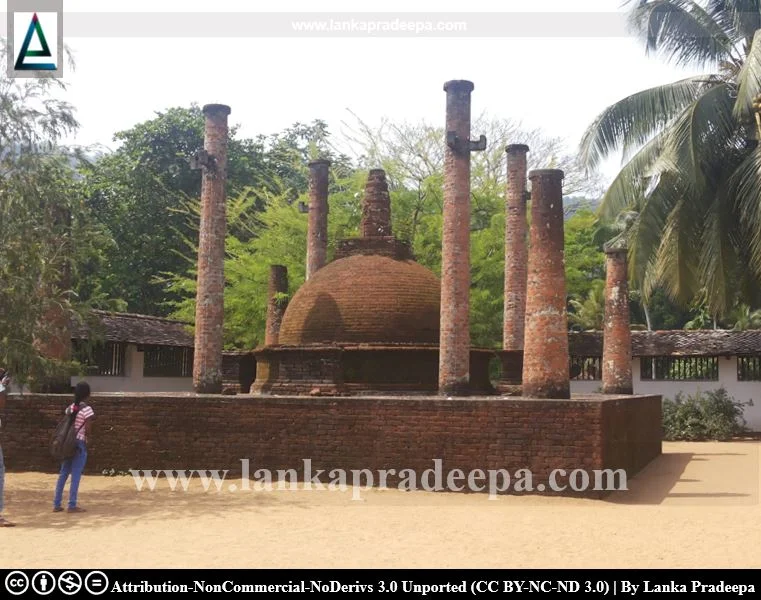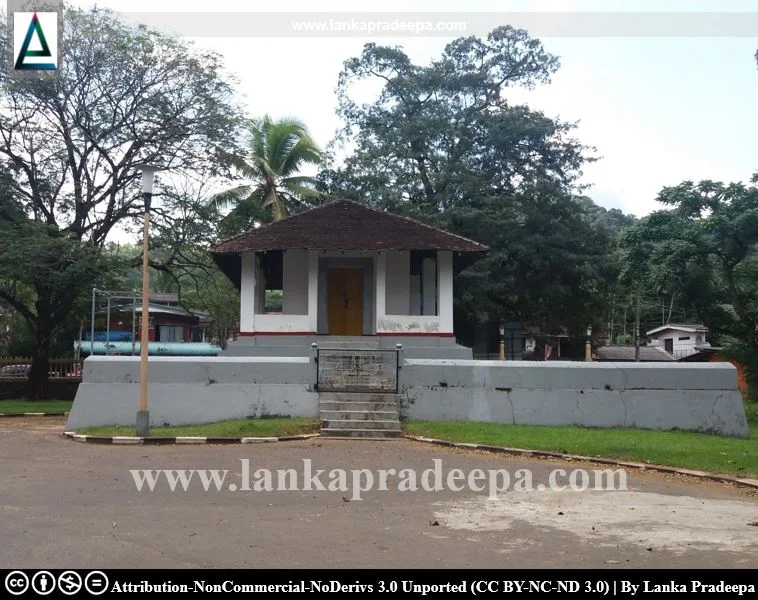
|
Maha Saman Devalaya |
Maha Saman Devalaya (Sinhala: රත්නපුර මහ සමන් දේවාලය) is a Devalaya Shrine dedicated to the god Saman and situated in Ratnapura District, Sri Lanka. The site can be reached by travelling along the Ratnapura - Panadura road about 3.5 km from Ratnapura town. The temple is also popular for its annual Perahera pageant held in July.
History
The history of Ratnapura Maha Saman Devalaya runs back to the Dambadeniya Period [(1220–1345 A.D.) Abeyawardana, 2002]. It is believed that this shrine was built by Aryakamadeva, the chief minister of King Parakramabahu II (1236-1270 A.D.).
In the beginning, it was a Buddhist temple of the Theravada tradition called by the name of Saparagrama Viharaya (or Saparagamu Vehera). According to the account found in Saman Siritha (an old poetry work), a monk named Viharavasi Seelawansa who was on a pilgrimage to Sri Pada had a dream and found a statue of god Saman in a rock cave at Sri Pada mountain. He brought the statue to the Saparagamu Vehera during a ceremony and subsequently, the temple was started to call "Saman Vehera".
During the reign of King Parakramabahu II, a vow of constructing a Devalaya for god Saman was made at Saman Vehera by Aryakamadeva, if he was able to find a trove of gems in the area. It is said that, after a successful gem expedition, he built a three-storied Devalaya for god Saman and gave jewellery, villages, and workers for its maintenance.
According to the Maha Saman Devalaya slab inscription of Parakramabahu VI (1415-1467 A.D.), Nilapperumalu, the grandson of Aryakamadeva had renovated this temple and received the titles Bandaranayaka and Basnayaka from the king (Rohanadeera, 2007).
In 1618, the Saman Vehera and Devalaya were destroyed and the debris had been put into the Kalu Ganga River by the Portuguese (Sarma, 2007). They constructed a church at the site and maintained it for 47 years. King Rajasinghe II (1629-1687 A.D.) captured the site in 1665 and reconstructed the Devalaya again. The shrine which is standing today at the site is said to be the structure erected during the 17th century by King Rajasinghe II.
Inscriptions
Maha Saman Devalaya Slab Inscription of Parakramabahu VI, 15 March 1454
Nilapperumal, the grandson of Arya-kama-deva Brahmin had renovated this temple by spending 2,600 as ordered by the king (Rohanadeera, 2007). For this service, the king gave Nilapperumalu two titles Bandaranayaka and Basnayaka. The king also donated several villages (those already bestowed to the temple by previous kings starting from King Parakramabahu II) and another new village named Sultota to Devalaya (Rohanadeera, 2007).
Maha Saman Devalaya Portuguese Inscription on the Sculptured Slab

A stone plaque depicting a Portuguese standing over a prostrate foe is found on the Devalaya premises (Abeyawardana, 2002; Perera, 1922). It contains an inscription written in the Portuguese language with Roman characters (Lewis, 1913).
Language: Portuguese
Script: Roman
Text: Com esta rendi este, ha 23 (?) annos que ando na India, e ha 15 (?) que sirvo de capitao; e taoque (?) os reis....de....(?) e o rei de Jafanapatao, eu Simao Pinhao o venci.
Translation: With this (sword) I overcame this (man), it being 23 (?) years that I have been in India, and 15 (?) that I have served as Captain; and as soon as (?) the kings....and the kings of Jafanapatao, I, Simao Pinhao, conquered him.
Citation: Lewis, 1913.
A bas-relief sculptured stone slab depicting the Cross of Christo and Portuguese Royal Arms is also found in the temple premise (Rohanadeera, 2007). This slab is considered a kind of monument that is referred to in Portuguese writings as Padrao (Rohanadeera, 2007).
A Protected Site
The ancient Maha Saman Devalaya, Alapatha Walawwa (the ancient official residence of the Basnayake Nilame), and the Buddha shrine with ancient sculptures and paintings of the Ratnapura Maha Saman Dewala premises situated in the Grama Niladhari Division of Dewalegava, in Ratnapura Divisional Secretary’s Division are archaeological protected monuments, declared by the government Gazette notifications published on 27 June 1952, and 6 June 2008.


Related Posts
Read Also
References
Books, Government Gazette Notifications, Journal Articles
1) Abeyawardana, H.A.P., 2002. Heritage of Sabaragamuwa: Major natural, cultural and historic sites. Sabaragamuwa Development Bank and The
Central Bank of Sri Lanka. ISBN: 955-575-077-7. pp.11-12.
2) Lewis, J.P., 1913. List of inscriptions on tombstones and monuments in Ceylon, of historical or
local interest: with an obituary of persons uncommemorated. Colombo. pp.286-287.
3) Perera, S.G., 1922. The Saman Devale inscription. The Ceylon antiquary and literary register. Vol. VIII: Part. I. pp.1-5.
4) Rohanadeera, M., 2007. Archaeological Survey of Ceylon: Inscriptions of Ceylon. (Vol. VIII). Department of Archaeology. ISBN: 978-955-91-59-64-3. pp.32-39.
5) Sarma, B.S., 2007. History of Munneswaram Temple. Sri Sankar Publications. p.21.
6) The Gazette notification. No: 10418. 27 June 1952.
7) The Gazette of the Democratic Socialist Republic of Sri Lanka. No: 1553. 6 June 2008. p.527.
Location Map
Dynamic Google Map
Attribution
To Whom
1) This image (Mural from Maha Saman Devalaya Ratnapura) was taken more than 100 years ago and therefore in the public domain. The original photo taken by Mr. J. W. Robertson of the Survey Department appeared in the Journal of the Ceylon Branch of the Royal Asiatic Society, 1899. Vol. XVI. No.50. pp.84-85.
2) LankaPradeepa.com extends its gratitude to Lalith Kekulthotuwage for providing the necessary photographs required for this article. All the photos are published here with the permission of the author.
රත්නපුර මහ සමන් දේවාලය
මහ සමන් දේවාලය ශ්රී ලංකාවේ රත්නපුර දිස්ත්රික්කයේ රත්නපුර නගරය ආසන්නව පිහිටි සිද්ධස්ථානයකි. රත්නපුර-පානදුර මාර්ගයේ රත්නපුර නගරයේ සිට කි.මී. 3.5ක් පමණ දුරින් මෙම දේවාලය පිහිටයි.
රත්නපුර මහ සමන් දේවාලයෙහි ඉතිහාසය දඹදෙණි යුගය දක්වා දිවයයි. 2වන පරාක්රමබාහු රජුගේ (ක්රි.ව. 1236-1271) ප්රධාන අමාත්යවරයා වූ ආර්යකාමදේව විසින් මෙම සිද්ධස්ථානය ඉදිකරන්නට ඇතැයි සැළකේ.
ආරම්භයේදී මෙම පුදබිම ථේරවාද සම්ප්රදායට අයත් සපරගමු වෙහෙර නමින් හැඳින්වූ විහාරයක් විය. පැරණි කාව්යයක් වූ සමන් සිරිතෙහි දැක්වෙන විස්තරය අනූව ශ්රී පාද වන්දනාවෙහි යෙදෙමින් සිටි විහාරවාසී සීලවංශ නම් භික්ෂුවක් සිහිනයක් දැක ශ්රී පාද පර්වතය පාමුල ගුහාවකින් සමන් දේව ප්රතිමාවක් සොයාගන්නා ලදී. ඔහු එම ප්රතිමාව සපරගමු වෙහෙර වෙත උත්සවශ්රීයෙන් වැඩමවූ අතර පසුව එම විහාරය සමන් වෙහෙර ලෙස හැඳින්වීමට පටන් ගති.
2වන පරාක්රමබාහු රාජ්ය සමයෙහි ආර්යකාමදේව විසින් සමන් වෙහෙරදී, තමන්ට මැණික් ඉල්ලමක් මතුකරගැනීමට හැකිවුවහොත් සමන් දෙවියන් උදෙසා දේවාලයක් ඉදිකරන බවට භාරවී තිබුණි. සාර්ථක මැණික් ඉල්ලමක් ලැබීමෙන් අනතුරුව ඔහු විසින් සමන් දෙවි උදෙසා තෙමහල් දේවාලයක් හා එහි නඩත්තුව වෙනුවෙන් ආභරණ, ගම්වර හා සේවකයින් ලබාදී තිබූ බව පැවසෙයි.
6වන පරාක්රමබාහු රජුගේ (ක්රි.ව. 1415-1467) මහ සමන් දේවාල පුවරු ලිපියෙහි, ආර්යකාමදේවගේ මුණුපුරෙකු විසින් මෙම සිද්ධස්ථානය අළුත්වැඩියා කොට "බණ්ඩාරනායක" හා "බස්නායක" යන පදවි නාම ලැබූ බව සඳහන් වේ.
වර්ෂ 1618දී, පෘතුග්රීසීන් විසින් සමන් වෙහෙර හා දේවාලය විනාශ කොට එහි සුන්බුන් කළු ගඟට දමා තිබුණි. පෘතුග්රීසීහූ පූජා පරිශ්රයෙහි පල්ලියක් ඉදිකල අතර එය වර්ෂ 47ක් දක්වා ඔවුන් අතින් නඩත්තු විය. වර්ෂ 1665දී, 2වන රාජසිංහ රජු (ක්රි.ව. 1629-1687) විසින් මෙම ස්ථානය අල්ලා ගනිමින් දේවාලය නැවත ඉදිකරන ලදී. වත්මන් පූජා පරිශ්රයෙහි දැකගත හැකි දේවාලය 17වන සියවසේදී 2වන රාජසිංහ රජු විසින් කරවන ලද ඉදිකිරීම් යැයි පැවසෙයි.
පුරාවිද්යා ස්මාරක ස්ථානය
රත්නපුර ප්රාදේශීය ලේකම් කොට්ඨාශයට අයත් දේවාලේගාව ග්රාම නිළදාරී වසමේ රත්නපුර මහ සමන් දේවාල පරිශ්රයෙහි පිහිටි පැරණි සමන් දේවාලය, ඇලපාත වලව්ව, පැරණි පිළිම සහ සිතුවම් සහිත බුද්ධ මන්දිරය 1952 ජූනි 27 හා 2008 ජූනි 6 යන දිනවල ප්රකාශයට පත් රජයේ ගැසට් නිවේදන මගින් ආරක්ෂිත පුරාවිද්යා ස්මාරක ලෙස නම් කොට ඇත.



